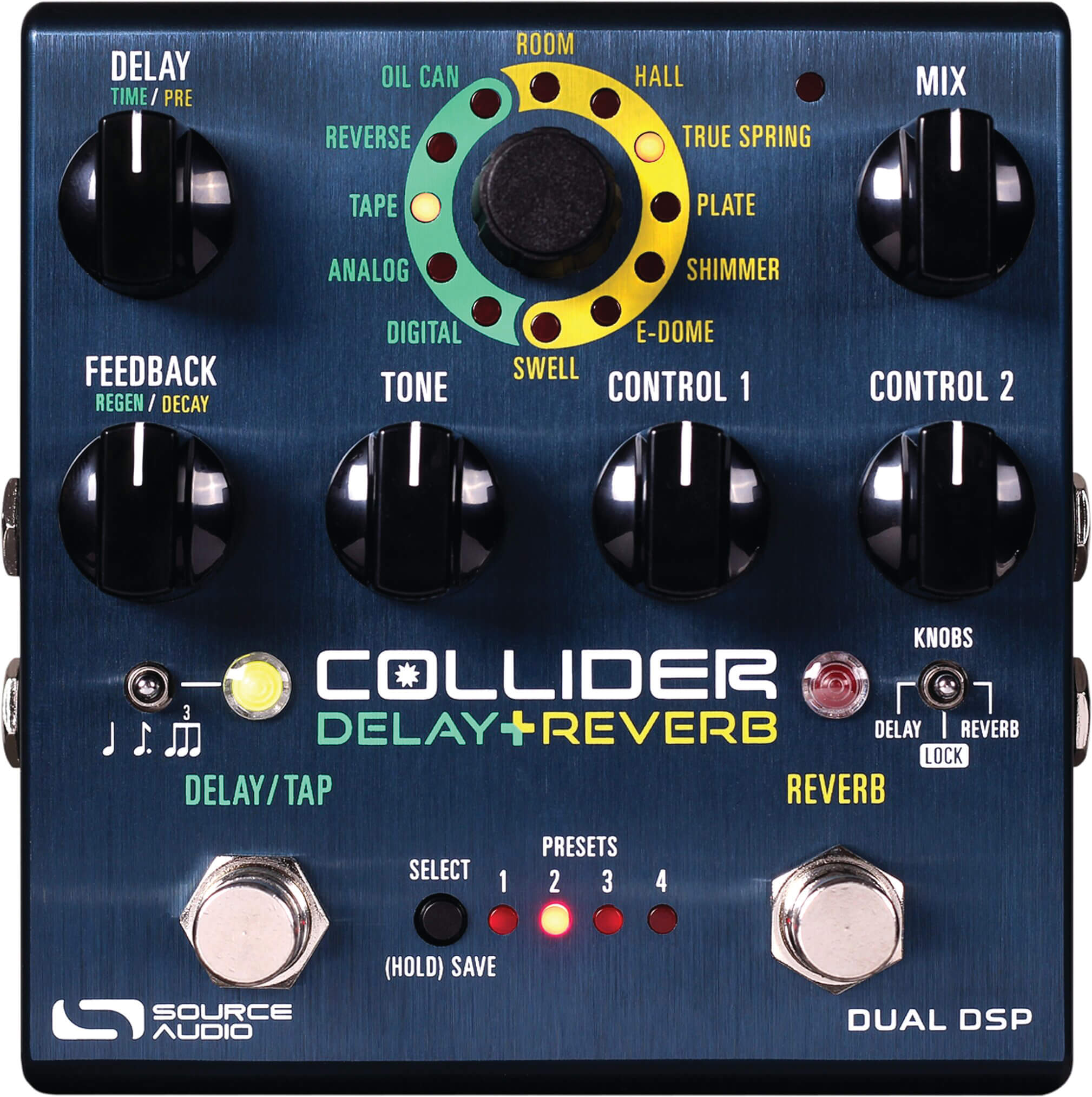Source Audio has brought together the best of their Ventris Dual Reverb and Nemesis Delay pedals into one compact unit and didn’t leave anything out in the process.
Let’s go over the Source Audio Collider’s connections; it’s stereo in and out and has in and thru for MIDI. On the rear, connection for expression pedal, or external switch options, the usual 9v power jack, and control for connecting the pedal to Source Audio’s Dual Expression Pedal, Neuro Hub, and Hot Hand Motion Controller devices. A USB connection for updates and connecting to a smartphone, tablet or computer for deeper editing and manipulation via their Neuro App.
There are seven different reverb types; room, hall, true spring, plate, shimmer, e-dome and swell. Add in the five delay types; digital, analog, tape, reverse and oil can, and it pretty much covers everything you’d need. Now these two effects share the same control knobs, which change different parameters depending upon not only the delay or reverb, but the particular type of delay or reverb selected. Going over the specifics of each would be a lot to consume, but they did include a cheat sheet for first time users.
A mini toggle switch selects which effect the controls work with, either the delay or reverb. Don’t you hate having to mark pedals with tape or a paint marker to your fave settings, because the knobs move around in the gig bag or get changed accidentally? It won’t happen when this lil switch is in the center “lock” mode. The other mini toggle covers the beat subdivision of the delays, with quarter, dotted eighths, and triplets. There is also a preset function, allowing the player to save four presets of delay and reverb, however, if it’s connected via MIDI, 128 presets can be stored and recalled.
With two separate footswitches, the player can control turning on or off the individual reverb or delay effects. Now these can be set to true bypass, buffered bypass, or soft bypass with delay trails. Tap tempo is also available, via footswitch, and to keep things further separated each effect is driven by its own DSP, which is why this pedal can do so much!

With each function and switch doing so much, you would think it’s tough to dial in sounds quickly, but we started with a simple goal to begin with; an amp like spring reverb, with an analog delay. Within a couple of minutes, we had it dialed in 90%. After referencing the “cheat sheet” we nailed the last 10%. Done. Quickly saving it, we moved on to a big rock solo, choosing the E-Dome and the Tape delay modes. Again, with some minor tweaking, it’s just THERE! Now the overall sound quality is fantastic, and the replication of the sonic inconsistencies of the tape and analog modes really blew our minds. Going to some extra extreme, the Shimmer and Reverse modes gave us a super big synth like pad that was amazing.
Want to dive deeper? With the Neuro editor app, all the parameters are laid out, so no having to toggle back and forth, and the ability to save more sounds is great. There’s also a community aspect to it, allowing users to share presets with others. Let’s say you found THAT Pink Floyd sound for guitars, or someone else has the perfect “Joshua Tree” delay, sharing these presets is easy to do.
Overall, for the player who wants to easily access every delay and reverb function possible, with minimal technical hassles, this has it covered. Players who just want to turn a few knobs and not have restrictions, there’s no problem there either. It’s reminiscent of the old studio rack units with way better sound quality, way more flexibility, and a much smaller footprint.
PROS:
hyper flexible, excellent sound quality, options and functionality galore!
CONS:
none.
STREET PRICE:
$349
